The good, the bad, and the beneficial.
Most people tend to think that the majority of insects are pest species, that will bring harm to their plants but before you squash or spray that insect, are you sure it’s a pest?
Many insects are actually beneficial to have in the garden and are an asset to your garden’s health. They often eat the real pest insects while being food for birds and wildlife in your backyard.
How can you tell what pests are friend or a foe?
If you are unfamiliar with an insect, watch it for a few minutes and it may reveal whether it is a pest that’s eating a plant or a friend that’s eating other insects or simply pollinating your plants.
Remember, too, that insects go through several stages in their life cycles, so it is important to become familiar with good bugs as eggs and babies (larvae) as well as adults.
A good example of beneficial insects that have multiple life cycles are lacewings that are called antlions when they are in their juvenile stage. As ant lions, they consume many pest insects.
Lady beetles are another one, in their juvenile larvae stage they consume 100’s if not thousands of aphids and mealy bugs. As adults, along with many other beneficials they are fantastic pollinators.
Good Bugs:
Bees, praying mantis, spiders, predatory mites, lacewings, hoverflies, ladybeetles, parasitic wasps, beetles, and dragonflies.
Bad Bugs:
Scale, mealy bugs, thrips, aphids, borers, bronze orange citrus bug, fruit piercing moth, vegetable bug, caterpillars, grasshopper, gall wasp, citrus leaf miner..png?width=194&height=345&name=Blog-bugs%20the%20good%20and%20the%20bad%20(Instagram%20Story).png)
* Remember though that these ‘bad’ bugs are a food source for so many good bugs. It’s when there’s a significant imbalance that it can become an issue.
Also, keep in mind that caterpillars and grubs are the larval stage of many beautiful butterflies, moths, Christmas beetles and the like.
Plus, they are a food source for many birds, possums, lizards, frogs and more.
Why imbalances and pest explosions occur.
Stressed plants are always going to be a target for pest insect species.
What can make a plant stressed?
- Planting vegetable crops at the wrong time of year.
- Growing plants that are out of their favoured climatic zone.
- Planting and growing plants in the wrong position in the garden – too shady, too sunny.
- Wrong soil pH, causing nutrient deficiencies.
- Using inorganic pesticides, which kill all the insects, good and bad. More often than not the pest species recover more quickly than the beneficials.
- Inconsistent watering
- Inconsistent nutrition
The less of the above you have going on in your garden the better!
To spray or not to spray
If your garden is full of biodiversity in the way of plant species, insects and wildlife you will find that given time the pest outbreak will more than likely be dealt with by naturally occurring sources.
If you’d sprayed immediately after finding a pest species, you would have potentially removed that vital food source.
If it appears that the pest insects are getting the upper hand, it may be time to employ some control measures. These measures should always be certified organic sprays and remedies. The majority of certified organic sprays are harmless to beneficial insects with the exception of pyrethrum.
Creating balance – biodiversity in the garden
I’m a strong believer in prevention is better than cure.
Don’t plant out of season crops. Don’t plant, plant species that aren’t climatically suitable. Don’t spray nasty insecticides.
Have a garden that attracts and provides habit for birds, lizards, frogs, beneficial insects and more.
Leave you leaf litter in place as habit for ground dwelling insects. Plant more trees. Use organic fertilisers and spray with certified organic sprays if critical.
_MEB.png?width=842&height=596&name=RP_HorizontalColour(R)_MEB.png)



